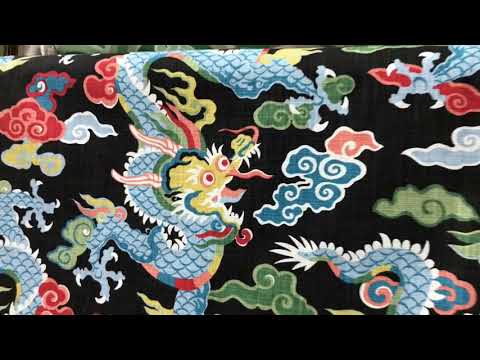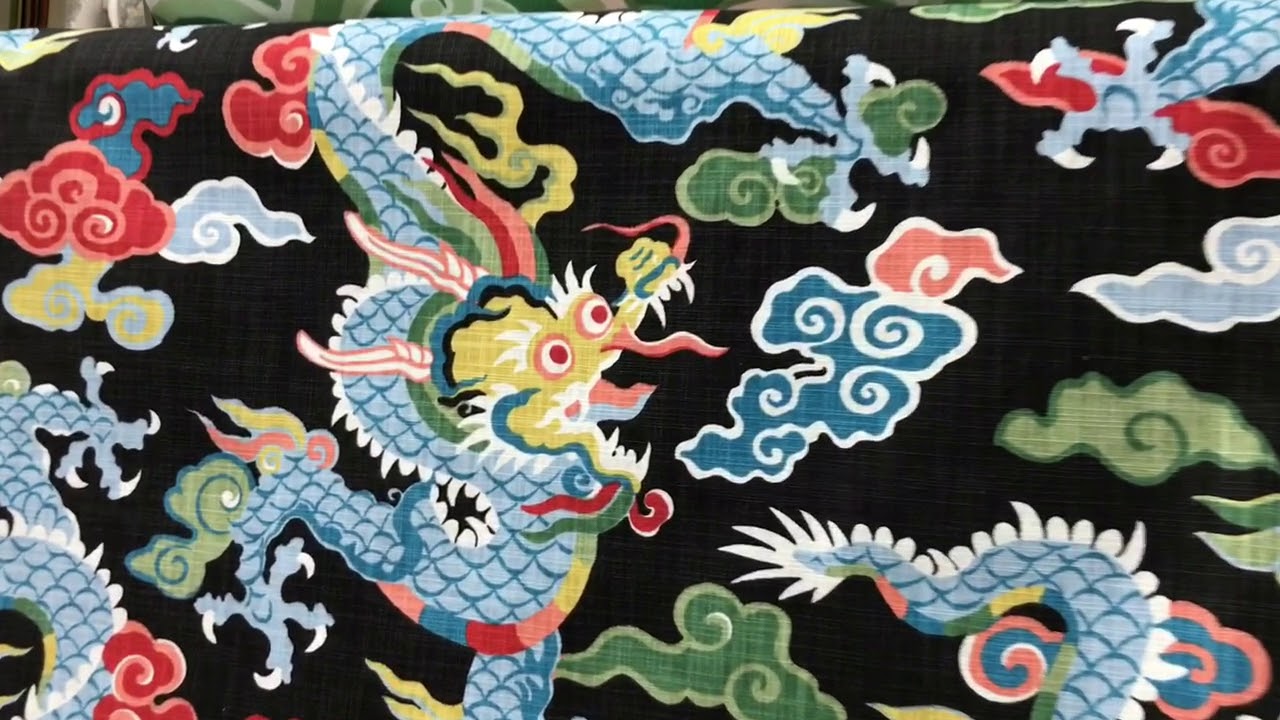Chinoserie fabric captivates with its timeless elegance and rich cultural history. Originating from China, this exquisite textile art form blossomed during the 17th and 18th centuries, captivating European aristocracy with its intricate designs and vibrant colors. The chinoserie fabric seamlessly blends Eastern and Western influences, incorporating traditional Chinese motifs such as pagodas, birds, flowers, and landscapes into a distinct and visually captivating style. Its delicate craftsmanship and attention to detail make it a true work of art, evoking a sense of enchantment and sophistication. The chinoserie fabric has stood the test of time, remaining highly sought after for its versatility and ability to enrich any interior or fashion ensemble. Whether adorning upholstery, curtains, or clothing, this fabric adds a touch of exoticism and refinement to any space. Its intricate patterns and vibrant color palette transport us to an enchanting world, where every thread tells a story. With its timeless charm, the chinoserie fabric invites us to embrace the beauty of cultural fusion and celebrate the unique blend of traditions that have shaped our global heritage.

The Beauty of Chinoserie Fabric: A Timeless Art Form
Chinoserie fabric, originating from the 17th century, is a unique and captivating art form that continues to enchant people worldwide with its intricate designs and delicate craftsmanship. This fabric style, heavily influenced by Chinese aesthetics, has a rich history and a timeless appeal that makes it a popular choice for interior design, fashion, and art enthusiasts. In this article, we delve into the origins, characteristics, applications, and enduring popularity of chinoserie fabric.
A Cultural Fusion: The Origins of Chinoserie Fabric
Chinoserie fabric emerged during the late 17th century in Europe when there was a fascination with all things exotic. The term “chinoserie” itself translates to “Chinese-esque” in French, indicating its inspiration from Chinese art and culture. European artists and craftsmen attempted to recreate the intricate designs found in Chinese porcelain, lacquerware, and textiles, adapting them to the European taste. This fusion of Eastern and Western elements resulted in the birth of chinoserie fabric.
Intricate Designs and Symbolism: The Essence of Chinoserie Fabric
What sets chinoserie fabric apart is its intricate designs and symbolic motifs. The fabrics often depict scenes from Chinese mythology, traditional landscapes, or botanical elements such as flowers, birds, and insects. These designs are meticulously hand-painted or embroidered onto luxurious textiles, creating a delicate and captivating visual display. Chinoserie fabrics also incorporate symbolic elements, such as dragons representing power and prosperity or peonies symbolizing wealth and honor, adding depth and meaning to the artwork.
Applications in Interior Design: Adding Elegance and Exoticism
Chinoserie fabric holds a special place in the world of interior design, as it effortlessly adds elegance and exoticism to any space. Whether used as upholstery, drapery, or wallpaper, chinoserie fabrics create a sense of opulence and sophistication. The intricate patterns and vibrant colors of chinoserie fabrics can transform a plain room into a visual masterpiece. From traditional to contemporary interiors, chinoserie fabric adapts to various design styles, making it a versatile choice for designers and homeowners alike.
Chic Fashion and Accessories: A Touch of Oriental Glamour
The allure of chinoserie fabric extends beyond interior design and has made its mark in the world of fashion. Designers often incorporate chinoserie-inspired patterns and motifs into their collections, adding a touch of oriental glamour to garments and accessories. From flowing silk robes to intricately embroidered handbags, chinoserie fabric elevates fashion pieces, creating a unique and eye-catching aesthetic. Its ability to effortlessly blend traditional elements with contemporary fashion trends makes chinoserie fabric a favorite among fashion enthusiasts.
Collectibles and Art: Chinoserie Fabric as a Cherished Treasure
Chinoserie fabric is not limited to interior design and fashion; it is also highly sought after as a collectible and art form. Antique chinoserie fabrics are considered valuable treasures, reflecting the craftsmanship and historical significance of the time. Museums and art collectors often display chinoserie textiles as exquisite examples of artistry and cultural exchange. Additionally, contemporary artists continue to create chinoserie-inspired pieces, pushing the boundaries of this art form and keeping it alive for future generations to appreciate.
The Enduring Popularity: Chinoserie Fabric’s Timeless Charm
Despite being centuries old, chinoserie fabric remains a beloved and popular choice across various creative fields. Its timeless charm and ability to blend seamlessly with different design styles have ensured its longevity. Chinoserie fabric adds a touch of elegance, exoticism, and cultural richness to any space or fashion piece it adorns, making it a treasured and versatile art form that continues to captivate people around the world.
In conclusion, chinoserie fabric is a testament to the power of cultural fusion and artistic expression. Its intricate designs, symbolic motifs, and adaptability have made it a timeless art form that transcends borders and captivates the imagination. Whether seen in interior design, fashion, or art, chinoserie fabric continues to enchant and inspire, reminding us of the enduring beauty of human creativity.
“Unveiling the Enchanting Tale of Chinoiserie Elegance: Dragon Lady’s Black Magic”
List of Chinoserie Fabric
Chinoserie Fabric
| Pattern | Origin | Characteristics |
|---|---|---|
| Floral | China | The floral pattern in Chinoserie fabric is heavily influenced by Chinese artistic traditions. It often features delicate, hand-painted flowers in vibrant colors, symbolizing beauty, nature, and prosperity. |
| Figurative | Japan | Figurative Chinoserie patterns commonly depict scenes of daily life, mythical creatures, or historical events. These designs showcase the intricate artistry and storytelling prevalent in Japanese culture. |
| Landscape | Europe | Landscape Chinoserie fabrics gained popularity in Europe during the 18th century. Inspired by Chinese paintings, these patterns often feature serene landscapes, pagodas, bridges, and exotic flora. |
| Toile de Jouy | France | Toile de Jouy is a quintessential Chinoserie fabric style that originated in France. It showcases intricate scenes, typically in a single color on a white or cream background. These motifs often depict pastoral, romantic, or historical themes. |
| Geometric | India | Chinoserie geometric patterns draw inspiration from Indian textile traditions. These designs feature intricate shapes, such as interlocking circles, diamonds, and repeating motifs, often in vibrant colors that reflect the rich palette of Indian textiles. |
Chinoserie fabric is a captivating fusion of Eastern and Western aesthetics, blending elements from China, Japan, India, and Europe. The patterns and designs found in chinoserie fabrics tell stories of cultural exchange, trade, and artistic collaboration. From delicate floral motifs to intricate landscapes, each style showcases the unique artistic traditions of its country of origin.
Floral Chinoserie patterns, originating from China, are characterized by their vibrant colors and hand-painted details. These designs often symbolize harmony, nature, and good fortune.
Figurative Chinoserie patterns, influenced by Japanese artistic traditions, depict scenes of everyday life, mythical creatures, or historical events. These designs reflect the meticulous craftsmanship and narrative storytelling prevalent in Japanese culture.
Landscape Chinoserie fabrics gained popularity in Europe during the 18th century. Inspired by Chinese paintings, these patterns often feature serene landscapes, pagodas, bridges, and exotic flora. They evoke a sense of escapism and admiration for the beauty of the Far East.
Toile de Jouy, a classic French Chinoserie style, showcases intricate single-color scenes on a white or cream background. These motifs often depict pastoral, romantic, or historical themes. Toile de Jouy fabrics became highly sought after during the Rococo period and continue to be cherished for their elegance and timeless charm.
Geometric Chinoserie patterns draw inspiration from India’s rich textile traditions. These designs feature intricate shapes, interlocking circles, diamonds, and repeating motifs in vibrant colors. The geometric patterns reflect the opulence and versatility found in Indian textiles, creating a captivating fusion of cultures.
Whether you are decorating your home or creating stylish garments, Chinoserie fabric offers a fascinating journey through history, art, and cultural exchange. Each pattern tells a unique story, bringing a touch of exoticism and elegance to any space or ensemble.

